If you’re interested to know about hojicha, read on to find out the basics of this tea, its history, culture significance, and a variety of ways to enjoy it. You’ll also find useful information such as tips when brewing it hot and cold, a couple of items to have for making it easier, and where to buy normal and special kinds of hojicha. For those who are looking for specific info, feel free to jump to the section you most want to know about.
What is Hojicha?

Hojicha (ほうじ茶 sometimes written as 焙じ茶) is a special kind of Japanese green tea. It’s known for its unique flavour and reddish-brown colour.
Compared to other green teas, hojicha has much less catechins and caffeine which gives it a smooth and mild taste. Along with its pleasant aroma and delightful flavours, hojicha is a great option to drink at any time of the day or night regardless of age.
The Unique Characteristics of Hojicha: Appearance and Flavour

Hojicha stands out from other Japanese green teas because of its unique look and flavours. This is due to the special roasting process it undergoes where green tea leaves and stems are roasted over charcoal at high temperature after being steamed, rolled and dried.
During the roasting process, the colour of the tea leaves and stems changes from bright green to reddish-brown as well as bringing out an earthy warm aroma and unique flavours. It also reduces the amounts of caffeine and catechins.
The most impressive thing about hojicha is its distinct flavour brought out from the roasting process, which is a mix of flavours including:
- Nutty: It reminds you of the warm smell of roasted almonds or hazelnuts, adding comfort to every sip.
- Toasty and Smoky: Think of the satisfying crunch of toasted bread with a subtle smoky flavour that stays in your mouth for a while.
- Sweet: Slight sweetness coming out after the toasty and smoky flavour, balances the roasted taste and creating a cozy flavour experience.
The Origins and Cultural Significance of Hojicha in Japan
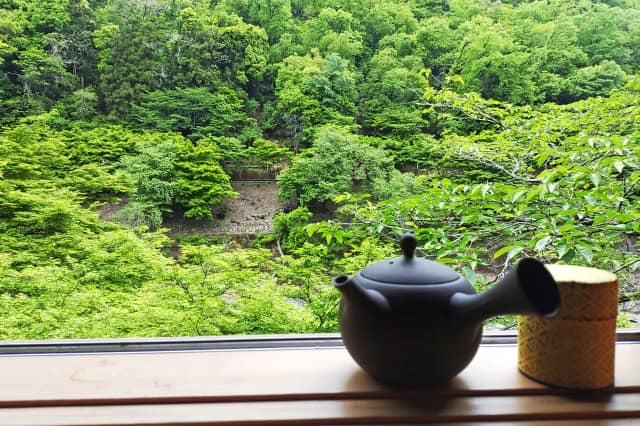
Our journey into the world of hojicha takes us to its home: the old city of Kyoto, where many of the rich Japanese traditions and tea culture lie.
The story of hojicha began in Kyoto, almost a hundred years ago when a tea merchant wanted to find a way to make use of leftover green tea leaves, stems and stalks after processing. He tried different methods and discovered that roasting them over charcoal created a brand-new flavour. This led to hojicha, a special tea with a soothing aroma and a smooth, toasty taste and it quickly spread to all over Japan.
Now, hojicha is enjoyed by tea lovers around the world. Its comforting taste, interesting background, and link to Japanese culture make it a very special drink.
Hojicha’s Place in Modern Japanese Tea Culture

Hojicha holds a special place in Japanese tea culture today. For formal tea ceremony purposes, matcha is the one to be drunk, however hojicha is to be enjoyed for everyday life. Its mild taste and warm aroma make it a favourite drink at family gatherings, peaceful evenings, and times to relax.
Usually, hojicha is drunk on its own, but it can be enjoyed in a variety of ways. Tea shops and cafes now use it to make lattes, smoothies, desserts, and even ice cream. This fresh take on hojicha shows how tea culture is changing while still respecting its deep roots.
Three Forms of Hojicha: Loose Leaf vs. Powder vs. Tea Bags
Hojicha comes in three different forms, each with its own benefits. Here’s a short description on each.

Loose Leaf: This is the most classic way to make tea and enjoy it. It gives you more control over how you brew it. It’s also a good way to find out how strong you want your tea to match your taste. For hojicha, you can steep the same tea leaves for a couple of cups or even more if desired.

Powder: The powder form simplifies things and is very flexible. It dissolves easily in water, so there’s no need to steep it. This makes it great for making lattes, smoothies and desserts. Hojicha powder also packs a strong flavour, and many people tend to love this intense tea experience.

Tea Bags: Tea bags or tea sachets are the easiest and cleanest way to make tea. No need for teapots, measuring or stirring. It doesn’t get messy, either. The best part of using tea bags is that you don’t have to deal with removing tea leaves from your teapot for when you’re feeling a little tired.
Whether you choose to use loose leaves, powder, or tea bag, it comes down to what you like best and how you want to use it. If you like, you can try all three forms, which can help you discover all the wonderful flavours hojicha has to offer.
Brewing Hojicha

Hojicha is very easy to make. You don’t have to worry about too much about details and you can make it how you like it although it will bring out slightly different aroma and flavours depending on the temperature and steeping time applied.
A couple of things good to remember when brewing hojicha are:
1) Use soft water and not hard water. If you’re using tap water, boil or filter it first to remove chemical odors such as chlorine.
2) To benefit from the instant release of its unique aroma, when brewing it hot, it’s recommended to use hot water above 95-degree C (203-degree F).
3) Better to refer to the directions on the package you bought to make it the best possible way. Bringing out its aroma and flavours the best, slightly differs according to which tea leaves used and how they’re roasted.
How to Hot Brew Hojicha

Loose Leaf
Recommended amount: 4 grams for 200 ml (1- 2 people) / 3 grams per person for 130 ml
1) Place 3 grams of tea leaves in a teapot. Adjust the amount to meet your needs. To make it stronger, increase the amount of tea leaves.
2) Pour hot water (90 – 95 degree C) or boiling water in the teapot. If preferred, lower temperature water (80 degree C – 90 degree C) can be used.
3) Leave it for about 30 seconds to steep before pouring the tea in a tea cup or mug. Adjust the steeping time to suit your preference. If your teapot doesn’t come with a built-in strainer, pour it through a tea strainer. Longer steeping time will make your tea stronger and it might bring out a little bitterness.
Tip 1: It’s always good to warm your teapot first by pouring hot water in a teapot and discarding the water before putting tea leaves in the teapot.
Tip 2: For the second cup, if you’re using the same tea leaves, use boiling water or near enough to boiling point water. You don’t need to steep it, but if you prefer, steep it for a short time.
Tip 3: Using a disposal filter bag (お茶パック) where you can put loose tea leaves makes your life easier in terms of cleaning and washing up. More info in the Where to Buy Hojicha section below.

Powder
Recommended amount: 0.3 – 0.5 grams for 100 – 200 ml / 1.6 grams for 240 ml
1) Place 0.5 grams of tea powder in a cup, mug or bowl. Adjust the amount to meet your needs and preference.
2) Pour a little amount of water in the cup/mug/bowl, and make it into a paste by mixing it well. Using a whisk instead of a spoon will make it foamy.
3) Pour hot water (90 degree C) and stir it well. If needed, adjust water temperature (80 – 95 degree C). No need to steep it. Add milk, soy milk and/or sweeter if desired.

Teabags
Recommended amount: 1 teabag (1.8 – 2.5 grams) for 150 – 160 ml / 1 teabag (3.5 – 5 grams) for 200 – 250 ml
1) Place 1 teabag in a cup, mug or pot. Adjust the water amount or the number of the teabags according to your needs.
2) Pour hot water (90 – 95 degree C) or boiling water in the cup, mug or pot. If preferred, adjust water temperature.
3) Leave it for 30 seconds. Pull the attached string up and down for a couple of times before taking the bag out of cup, mug or pot. Put a lid on while steeping if desired. Adjust the steeping time to suit your preference. Longer steeping time will make your tea darker and stronger as well as bringing out a little bitterness.
Tip 1: You can adjust the strength of the tea by pulling the attached string up and down. More pulling will make the tea stronger.
Tip 2: If your tea gets too strong or too dark, you can add some water to dilute it.
Tip 3: Once it’s made, it’s always good to remove the teabag from your cup/mug/pot to avoid getting it cloudy.
How to Cold Brew Hojicha
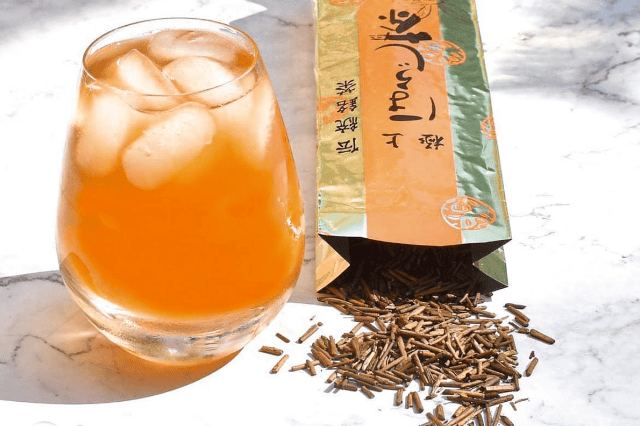
Loose Leaf
Recommended amount: 7 – 10 grams for 700 ml – 1 liter / Approx.1 gram per 100 ml
1) Place 10 grams of tea leaves in a pitcher or bottle. *Adjust the amount to suit your needs and preference.
2) Pour room temperature water or cold water in the pitcher/bottle.
3) Leave it for a couple of hours or more in the refrigerator before pouring the tea in a tea cup or glass. Depending on the tea leaves you use, the steeping time varies from 1 hour to 8 hours. Check the taste from time to time to see if longer steeping time is required. If you’re not using a built-in strainer pitcher or filter-in bottle, pour it through a tea strainer. Add some ice cubes if desired. You should consume the tea within 24 hours.
Tip 1: For making iced hojicha quickly, you can brew it hot first and add ice cubes into it straight away. If you’re worried about the tea getting weaker, you can always increase the amount of tea leaves when brewing it hot.
Tip 2: If you find your tea too strong or bitter, you can add some water to dilute it.
Tip 3: Using a filter-in bottle or a disposal filter bag (お茶パック) is a great option when making cold brew tea. More info on these: Where to Buy Hojicha section and Kyusu Teapots & Filter-in Bottles and Mizudashi Cold Brew Tea Makers section.

Powder
Recommended amount: 0.3 – 0.5 grams for 100 – 200 ml / 1.6 grams for 240 ml
1) Place 0.5 grams of tea powder in a cup or bowl. Adjust the amount to suit your needs and preference.
2) Pour a little amount of water in the cup/bowl and make it into a paste by mixing it well. Using a whisk instead of a spoon will make it foamy.
3) Pour room temperature or cold water in the cup/bowl and stir it well. No need to steep it. Pour it into a glass and add ice cubes, milk, soy milk and/or sweetener if desired.

Teabags
Recommended amount: 1 teabag (1.8 – 2.5 grams) for 150 ml – 160 ml / 1 teabag (3.5 – 5 grams) for 200 ml to 500 ml / 1 teabag (5 – 7 grams) for 700 ml – 1 L
1) Place 1 teabag in a cup, pot, or bottle. Adjust the number of teabags according to your needs and preference.
2) Pour room temperature water or cold water in the cup/pot/bottle. If needed, adjust the water amount.
3) Leave it to steep in the refrigerator before pouring the tea in a tea cup or glass. Average steeping time for a 1.8 – 2.5 g teabag: 2 – 3 minutes (no need to put in a fridge unless desired), for a 3.5 – 5 g of teabag: 1 hour in the refrigerator, for a 5 – 7 g of teabag: 2 hours or more. Check the taste to see if longer steeping time is required. Add some ice cubes in the tea cup/glass if preferred. You should consume the tea within 24 hours.
Tip 1: If your tea gets too strong or bitter, you can add some water to dilute it. In case of weak tea, try shaking your bottle or pulling the attached string up and down, which will make it slightly stronger.
Tip 2: Once it’s made, taking a teabag out of a cup/bottle will be a good idea as it can get cloudy as well as bringing out a little bitterness.
Kyusu Teapots & Filter-in Bottles and Mizudashi Cold Brew Tea Makers
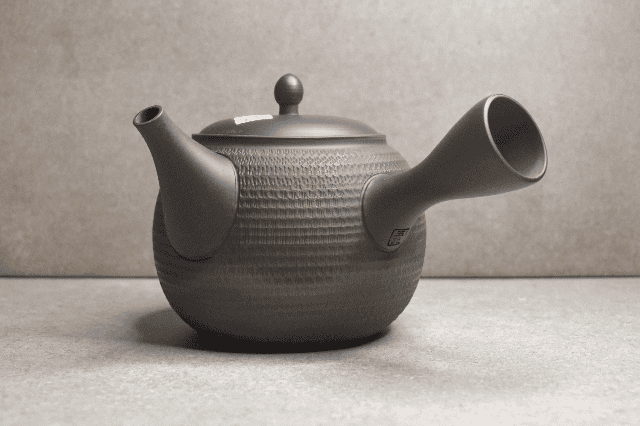
Kyusu Teapots
For making Japanese green tea, you can use an ordinary teapot. However, using a traditional Japanese kyusu teapot will make your tea time more enjoyable and flavourful. Kyusu is a small teapot with a side handle, and not only nice to look at it but also it brings out the better flavour in the tea as well as stopping unwanted leaves from getting into your cup.
You can purchase a good quality teapot from many tea shops and online stores, but if you’re residing in the UK, have a look at Tencha’s Teapots and Kyusu page as they sell a selection of Tokoname Kyuse including Tokoname: Fire Kiln Varnished Kyusu and Tokoname: Large Smoked Black Kyusu (both are ideal for larger leaves such as hojicha). Tokoname Kyusu is recognized as the best kyusu in Japan, due to mostly unglazed on the inside which makes tea nicer by getting rid of undesired tastes as well as bringing out more mellowness in flavour.

Filter-in Bottles & Mizudashi Cold Brew Tea Makers
Mizudashi is a Japanese word for a cold brewing method. When making cold brew tea, filter-in bottles and cold brew tea makers with built-in strainers are really good to have as it can make your life easier. Usually, Amazon offers a range of these items, and Amazon UK has quite a few Hario products to choose from. Hario is a well-known Japanese heatproof glass maker and has been manufacturing quality products over 100 years. Their products are often used by tea shop and café owners in Japan, and are easy to handle, clean and dishwasher safe.
Hario “Mizudashi” Cold Brew Tea Maker 1200 ml comes with a built-in strainer and can be used for both tea bags and tea leaves. Also, it fits easily in the fridge. As for Hario’s filter in bottles, Cold Brew Tea Wine Bottles come in 3 sizes, 750 ml which is ideal for family or a full day consumption, whereas 160 ml and 300ml ones are great when you want just one or two cups, and are practical for carrying.
Where to Buy Hojicha
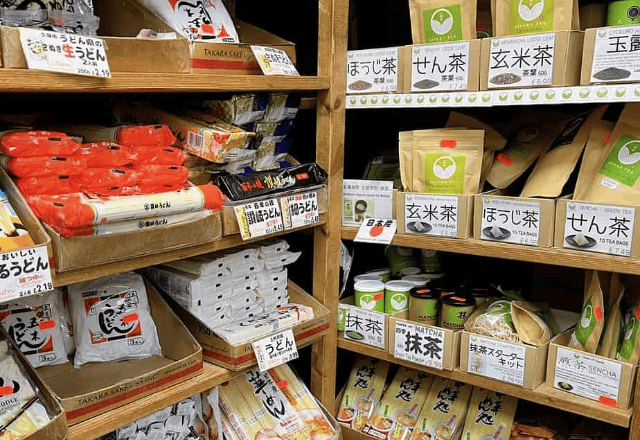
Whether it’s a loose leaf, powder or teabag type, Japanese grocery stores and supermarkets usually carry all three types. As most of those shops have online shops, you can get your orders delivered to your place. Or if you prefer, you can check and get them from Amazon.
Here are some of the items that we’ve picked to show you what hojicha products are usually available from Japanese Supermarkets in London which can be delivered across the UK.
1) Ito En Oi Ocha Hojicha (roasted green tea) 20 bags from Japan Centre: Product from Ito En, famous green tea brand. Easy to make. Great for both hot and cold brewing.
2) Tsuboichi Bou Hojicha Latte Mix 100g from Rice Wine Shop & T.K.Trading (Language option on the top right corner): Instant Hojicha Latte base that you can mix with milk, soy milk or even almond milk. Easy and Good for both hot and cold.
3) Ocha Pack M お茶パック Disposal Tea Filter Bags from Natural Natural (Online shop Asian Harvest): Great for making tea with loose leaves as you can just throw the bag with the tea leaves after you’ve used.
The above products or similar ones are available at other Japanese supermarkets or online shops including Amazon UK.
Quality Hojicha, Specialty Blends and Organic Hojicha

For those who prefer to get more refined quality hojicha, the best way sourcing this is to head to people who specialise in Japanese green tea. They have quality tea which they get from Japanese tea farms who often provide detailed information on the tea including its background, when and where the tea leaves are harvested, how they’re processed and which farmer produced it.
If you’re looking for something special, you might like to try some of the specialty hojicha blends with herbs, spices or genmai (brown rice). These blends not only provide exciting tastes but also offer a unique experience of the mixed flavours creating wonderful aromas.
Meanwhile, if you’re more an organic product person, you can get organically produced hojicha from some of the tea shops focusing on Japanese green tea as well as some Japanese supermarkets and on Amazon.
Sourcing Quality Hojicha and Specialty Blends in the UK

If you’re in the UK, Tencha is good to check out as they stock quality teas which they get from farmers they know and trust. For hojicha, they mainly have loose leaf type but you can get it in a powder form from them as well as specialty blends such as Genmai Hojicha and Sansho Pepper Hojicha.
Tencha are not only knowledgeable and experts in Japanese tea, but they are also friendly and helpful. It’s worth visiting them if you’re in London or you can check online what they’re offering from a selection of teas and tea related items to Japanese arts and other Japanese products including good luck charm ornaments and bracelets. They offer free 24-hour tracked shipping in the UK for orders over £60.
Sourcing Organic Hojicha in the UK
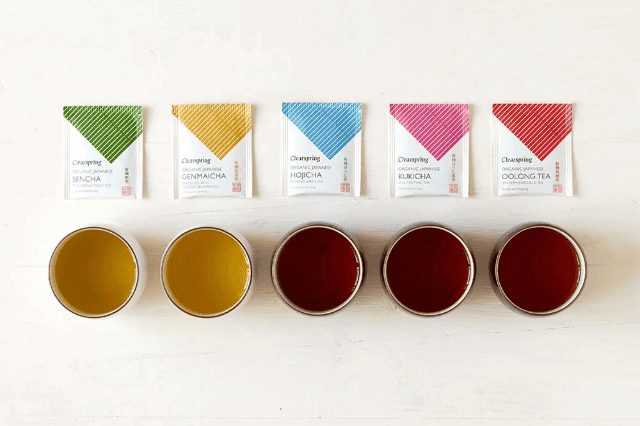
Clearspring is a well-known brand for Japanese specialties and organic fine foods. They’ve been running their family business for over 30 years, and you can easily find organically produced Japanese foods and drinks from their ranges. Their products are usually available from Amazon and Japanese supermarkets as well.
As for hojicha, their organic products come in loose leaf type and teabags. Their Organic Japanese Tea Selection – 5 Sachets is ideal for people who haven’t tried hojicha as it comes with 5 different kinds of Japanese teabags. They offer free UK mainland delivery for orders over £50 or if you prefer, you can pick them up from their warehouse.
Conclusion

Exploring hojicha is a wonderful way to experience Japanese tea culture. Its roasted taste and interesting history make it special for tea lovers. Now that hojicha is intriguing with so many forms, not only you can enjoy the warm aroma as you take each sip, but also you can cold brew it or use it to make latte, smoothies, cakes, ice creams and much more. If you haven’t tried it yet, why not take this opportunity to embark on an enjoyable Hojicha tasting adventure!
For those wanting to learn more about Japanese green tea, take a look at 13 Types of Healthy Japanese Tea you should know. Meanwhile, if you’re seeking more information on Japanese Foods and Supermarkets, check out our Best Japanese Supermarket in London. We also have articles on Japanese Culture in our Culture section. Or you can head to our Instagram account for posts of recent festivals, events, and restaurants we’ve been to.
Disclaimer: All information is correct at the time of publishing and we will review regularly to ensure it stays updated. However, we would recommend checking each seller or manufacturer’s website for the latest information.
Disclosure: We only recommend products and services we would use ourselves and all opinions expressed here are our own. When you make a purchase through links on this page, we may earn an affiliate commission, at no cost to you.


